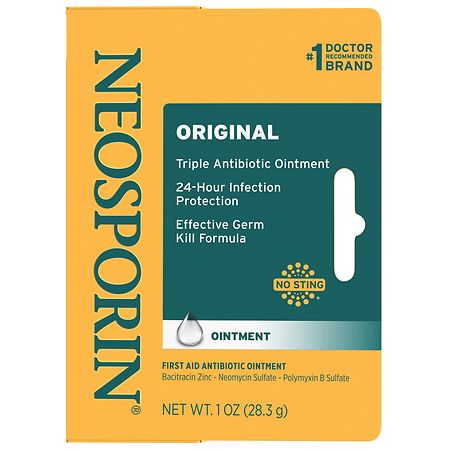Antibiotic Ointment
More information about Antibiotic Ointment
You may be out in the garden, cooking or repairing something in your home when you find yourself with a cut or a burn. That’s why it’s a great idea to have a first aid kit stocked in your home for small injuries that can occur at any time. In addition to bandages, antiseptic spray and other items, antibiotic ointment is an important product to include in your kit as it can help prevent infection in small skin breaks. If a wound is deep or complex, you should see a healthcare professional for further evaluation since you may need a tetanus shot or sutures. You can find many different antibiotic ointments and creams at Walgreens in store and online. If you haven’t had a tetanus shot in the last five years or you can’t remember the last time you received one, you can also schedule your vaccine with your Walgreens pharmacist.
What is antibiotic ointment?
Antibiotic ointment is a topical product that contains an antibiotic or combination of antibiotic ingredients to stop bacteria growth in a superficial wound, such as a cut, scrape or minor burn. Many antibiotic ointments commonly contain the active ingredients neomycin, polymyxin and bacitracin, which work by stopping the growth of certain bacteria. Some OTC antibiotic products may contain additional ingredients to help with other symptoms, such as:
- Hydrocortisone to reduce swelling or inflammation
- Lidocaine to lessen pain
- Pramoxine HCL to help reduce itching and pain
Other products may also help with wound healing, insect bites and stings with ingredients like ichthammol and calendula.
When is antibiotic ointment used?
Antibiotic ointment is intended for use on superficial cuts, scrapes or burns. You may use antibiotic ointment as soon as the injury has occurred and once you’ve cleansed the wound. Antibiotic ointment may help with healing by keeping the wound moist for skin repair and free of infection. Some people may experience a mild rash when using antibiotic ointment. When this occurs, petroleum jelly may be used instead. You should see a healthcare provider if a wound shows signs of worsening, including increased pain, swelling, fever or redness that spreads on the skin.
Can antibiotic ointment be used on deep wounds or surgical incisions?
Surgical incisions should be cared for as instructed by your healthcare professional. Some surgical incisions may require a bandage cover to remain for some time following surgery, with special care taken in the shower. You should carefully follow all post-surgery care instructions given. Antibiotic ointment isn’t commonly recommended as part of post-surgical wound care, but other topicals may be recommended for preventing scars. Deep wounds may require evaluation from a healthcare provider as well. Some wounds may need additional medical attention, such as stitches, to help with healing.
How often should I apply antibiotic ointment?
Every wound is unique, and how often to apply antibiotic ointment will depend on the wound type and location. Antibiotic ointment is typically applied one to three times a day on the skin. However, if the wound is on your hand or another area that’s washed often, you may need to reapply.
Can I use antibiotic ointment on my face for facial wounds or acne?
You can use antibiotic ointment for facial wounds, such as a scratch or cut. However, these ointments may sometimes cause allergic contact dermatitis on sensitive skin. Certain prescribed topical or oral antibiotics can better target bacteria that causes acne. OTC products that contain benzoyl peroxide and salicylic acid are formulated particularly for acne care. Ask your Walgreens pharmacist about acne products that may be most appropriate for your acne symptoms.
Antibiotic ointment can be helpful for infection prevention and healing in minor skin injuries. You can also use a bandage to protect the wound from further injury and dirt. Find these and other first aid items at Walgreens in store and online. Your pharmacist can help you choose essential products to keep in your home in the event of an injury.


 Walgreens
Walgreens






